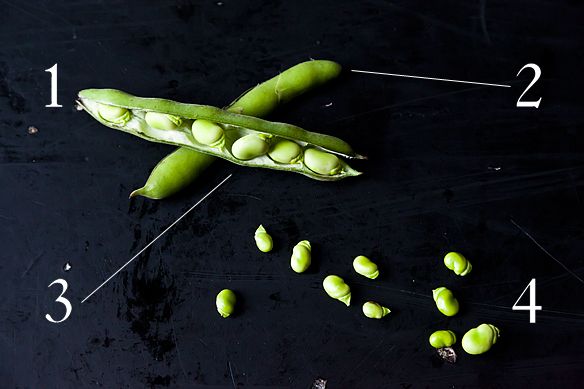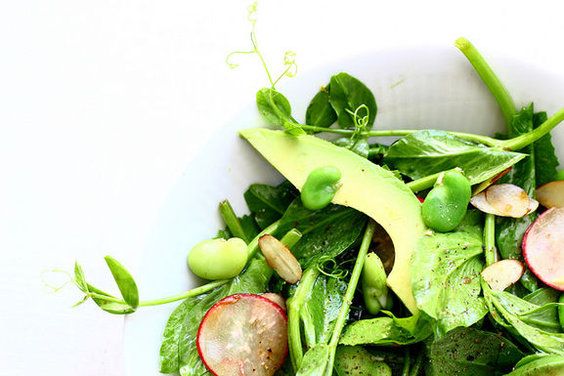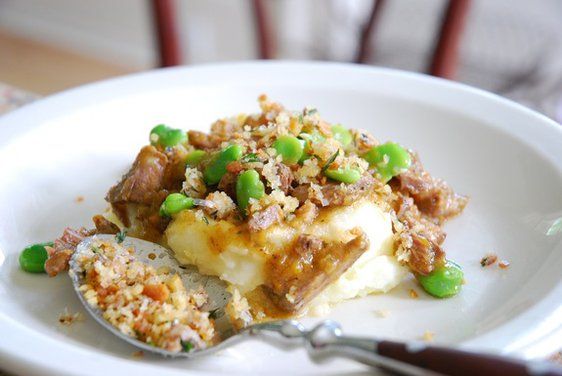Every week we get Down & Dirty, in which Nozlee Samadzadeh breaks down our favorite seasonal fruits, vegetables, and more by the numbers.
Fava beans aren't afraid to give you a hard time -- what other vegetable needs to be shelled twice? But they're worth it. Their intensely green pods are used in spring dishes all over the Mediterranean world, from Italy (in the spring stew la vignarola) to Iran (blanched and tossed with angelica). FOOD52er innoabrd's Besara -- think of it as Egyptian hummus -- is another classic preparation.
As you blanch and peel your fava beans to tender perfection, here's more about them, both inside and out.

1. Triplets or Duedecuplets: Depending on variety, each fava bean pod holds between 3 and 12 nestled-together beans. To get inside, "string" the pods like you would a snap pea, by snapping off the stem and pulling down across the pod.
2. Easy Being Green: The outer shell of a fava bean should be velvety and smooth, and evenly green. Look for pods with the stem end attached -- that's a good sign that they were picked at full maturity, rather than being clipped from the branch. You may see black spots on some fava bean pods which, according to the University of California Specialty and Minor Crops Handbook, is caused by fungus brought about by wet growing seasons. Don't sweat it -- the beans inside are perfectly healthy.
3. Buying by Touch: At market, feel for firm fava bean pods with even spacing. Loose pods indicate that the beans aren't fully mature, or that they fell victim to aphids!
4. Favism: As fava beans mature, they develop higher levels of tyramine, an amino acid. According to the UC Davis Small Farm program, if you have a hereditary enzyme deficiency called favism, you may get sick when eating raw or undercooked favas. Play it safe -- blanch your beans!

5. Shelling, Twice: Once you pop fava beans out of their pods, you're halfway there: the beans are covered further by a pale green membrance that protects the brighter green bean inside. You can gently score this shell with your thumb and peel it off -- if the beans are very large, this is made much easier by first blanching the beans and letting them cool in an ice bath.
6. Fresh or Dry: Finally, the fava beans themselves! Eaten fresh, they have a buttery, green taste and can be used for everything from crostini to traditional Iranian baghali polo -- rice steamed with dill and fava beans. They can also be blanched and frozen, or dried and stored just like any other dried bean. Many older recipes recommend boiling for upwards of 25 minutes -- we recommend cooking them until tender, just a few minutes.
Ready to start cooking? Most recipes -- like this pea shoot salad and these braised beef shanks -- draw on fava beans themselves, but you can also grill and eat the pods whole!



I'm Nozlee Samadzadeh, a writer, editor, farmer, developer, and passionate home cook. Growing up Iranian in Oklahoma, working on a small-scale organic farm, and cooking on a budget all influence the way I cook -- herbed rice dishes, chicken fried steak, heirloom tomato salad, and simple poached eggs all make appearances on my bright blue kitchen table. I love to eat kimchi (homemade!) straight from the jar and I eat cake for breakfast.






See what other Food52 readers are saying.